How to Sign Off an Email to Engage Your Customers and Boost Sales
When was the last time you checked your email sign-off? If it’s been a while, it would be smart of you to take another look at it and see how you can improve it. Copywriter Lesley Vos gives you some valuable tips and email signature examples in the article below.
First, the question:
When writing an email, what parts of the content do you think most influences your conversion rate?
Your subject line? Your calls-to-action (CTAs)? What about emojis? Guess what — all of these matter. Email sign-offs, on the other hand, don’t get the attention they deserve. Surprisingly, many marketers still underestimate the power of a good sign-off.
Today, email signatures have turned into marketing tools you can use to:
- raise brand awareness
- establish trust
- drive clicks and conversions
- improve sales.
But how do you sign off an email to use its marketing power to the maximum? Let’s talk about it and take a look at some examples.
What is an email sign-off?
An email sign-off is the part of your message right after the CTA and the closing line (such as “Sincerely,” “Regards,” “May the force be with you” and others).
Professional email sign-offs provide more than a name and position. They include details and CTAs, have an eye-catching design and serve as an extra promotional tool.
Here’s an example:
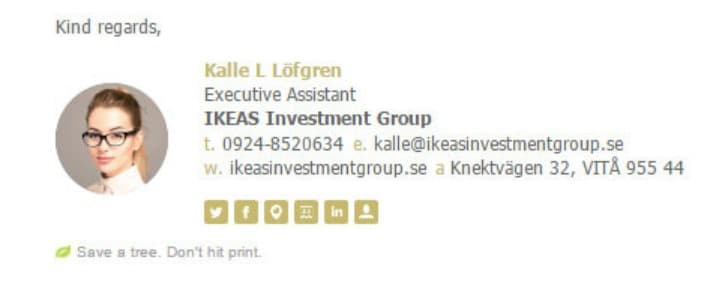
Let’s think about email sign-off as digital business cards that are a part of your branding and help you achieve your marketing goals.
This text block in an email footer has already evolved into a separate form of marketing: email signature marketing. Savvy marketers and sales pros implement email sign-offs into their strategies to support ongoing campaigns and engage more customers.
The psychology behind email language: why email sign-offs matter
Your email sign-off is the last thing recipients see, so it tends to stay in their minds before they click your link. And you want to leave them with a positive impression, correct?
From a psychological perspective, the words and tone you use in your email sign-offs may spark different feelings and influence a person’s reaction to your message.
For instance, a 2017 study showed that “Thanks in advance“ generated the most responses. Experts still argue what email niceties work best for particular audiences. But the fact is we need to pay attention to how we sign off an email if we want to evoke an emotion in your audience.
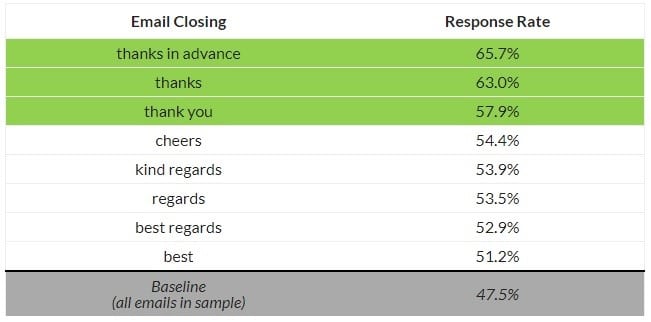
Image by Boomerang App
From a marketing perspective, the information you share in email sign-offs works to:
- inform your audience about you and your business
- educate your audience about your brand
- add a personal touch and build an instant connection
- build trust
- tell your audience about your product and deals
- advertise your latest content and events
- make your brand more accessible
- generate traffic to your website (via well-positioned links or a CTA to inspire action)
Marketing emails aren’t the only ones that can benefit from an engaging signature. Students who write an email to a teacher, entrepreneurs writing corporate newsletters and freelance creatives willing to hook potential clients — all of these can use engaging email signatures to get a response.
Email sign-offs matter. They influence someone’s impression of you and their desire to deal with you.
Features to include in your email sign-offs
Email signature marketing is about two main goals: brand awareness and the support of ongoing marketing campaigns. With that in mind, consider the following features to add to your sign-offs:
A photo
It adds personality to your email and helps you build trust. Also, it’s your chance to “humanize” your brand. Recipients will see there’s a human behind marketing messages, most of which they consider automatic.

A phone number
It make you more accessible and trustworthy.
A website and social media icons
They increase engagement, drive traffic and help you get new followers.
A logo and a slogan
It strengthens brand awareness. Brand colors and fonts in a sign-off will make it even more memorable and recognizable.

A CTA or a banner: It supports your ongoing marketing campaigns. You can add CTAs with links to your latest content, case studies, webinars, newsletter subscriptions or deals to improve sales.
How to sign off an email: 5 rules for better engagement
Here’s what you can do to make an email sign-off resonate with your target audience and engage them.
#1. Make your email sign-off personal
Email is about personal communication, even if you write on behalf of a brand. Add a pinch of personality to your email sign-off, and you’ll see the difference in engagement.
The first and foremost instrument to give your email warmth and authenticity is a high-quality photo.
As a marketer, you probably know that photos with faces perform better. That’s because of people’s subconscious attention to eye gaze, which builds a stronger emotional connection, positive impact and trustworthiness.
A professional-looking photo of a person adds credibility, helping recipients match a name with a face and remember your message better.
You can take a step further and try an animated live image for your email sign-off to make it stand out.
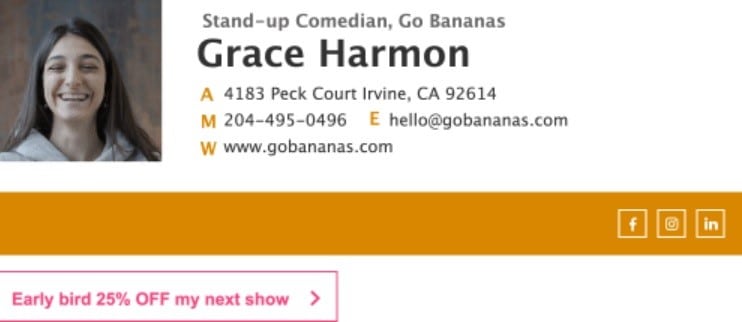
Or create a GIF picture from your photos, like Jed did, to showcase his personality to his audience and add some authenticity to his cold marketing messages.
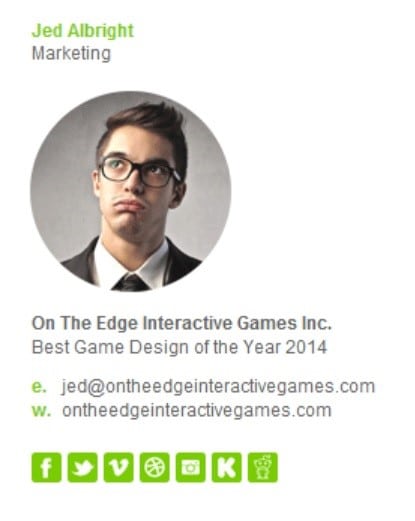
Another instrument to try here is a handwritten sign-off. It adds a personal touch to your email, making it even more human and relatable.
If your brand voice allows, consider adding some drawings like smileys or abbreviations like “XOXO” to a sign-off. When used appropriately, such a lovely detail will signal your transparency and care.
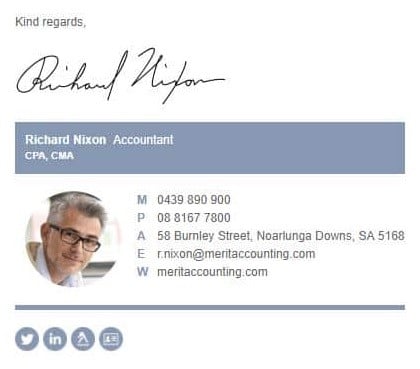
#2. Design it to match your branding
Two rules here:
- Make your email sign-off minimalistic
- Stick to your brand colors
Your customers need to have consistent brand experiences through all your marketing channels. Email is one of them, so ensure consistency when designing your sign-off.
First, use your brand colors: Take their HEX codes and paste them into your email sign-off generator.
If you have brand fonts, feel free to use them in your email sign-offs, too. Remember, though, that your signature needs to be eye-grabbing and engaging but not distracting. Keep it clean and concise, following the principles of minimalistic design:
- Limit the number of design elements
- Avoid including more than seven lines
- Align all the lines to the left
- Use whitespace between the elements
- Avoid overly fancy web fonts
- Separate content with dividers for easy scanning
- Use two colors, don’t jam-pack your sign-off with design elements
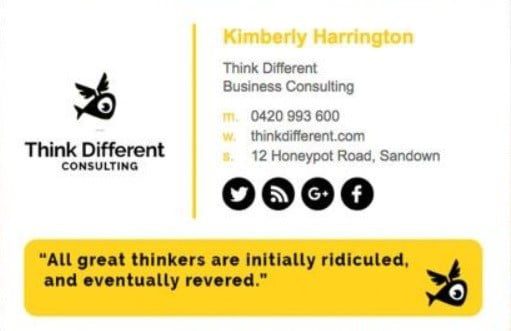
#3. Optimize for mobile devices
Remember that 85% of users use smartphones to access email today, so you need to optimize your sign-offs accordingly. Modify a signature for it to look professional on small screens of mobile devices:
Consider vertical templates with well-spaced images and buttons. Use your Google Play or App Store links for CTAs to make it easier for customers to access your offer from smartphones.
#4. Try banners to boost conversions
By optimizing your email sign-off as a banner, you’ll showcase your expertise and add an element of promotion to support your marketing. It works as an extra instrument to boost conversions.
Even when you send newsletters or customer support emails, your sign-off will continue to engage recipients with your offer.
Here’s what to insert in your sign-off banner:
- Blog posts. Encourage readers to check your latest article, which drives more traffic to your website.
- Product announcements. It’s a good spot to highlight a recent launch or update.
- Upcoming events. Conferences, webinars, book releases, product launches — you name it! Remember to include the information about when and where your event will take place.
- Certificates. Show off your expertise to your audience so they know you’re worth their trust.
- Surveys. Ask for feedback to get quick insights from customers. Add the corresponding emojis to a sign-off banner to engage users to reply in one click.
- YouTube videos. Invite people to check out your YouTube channel.
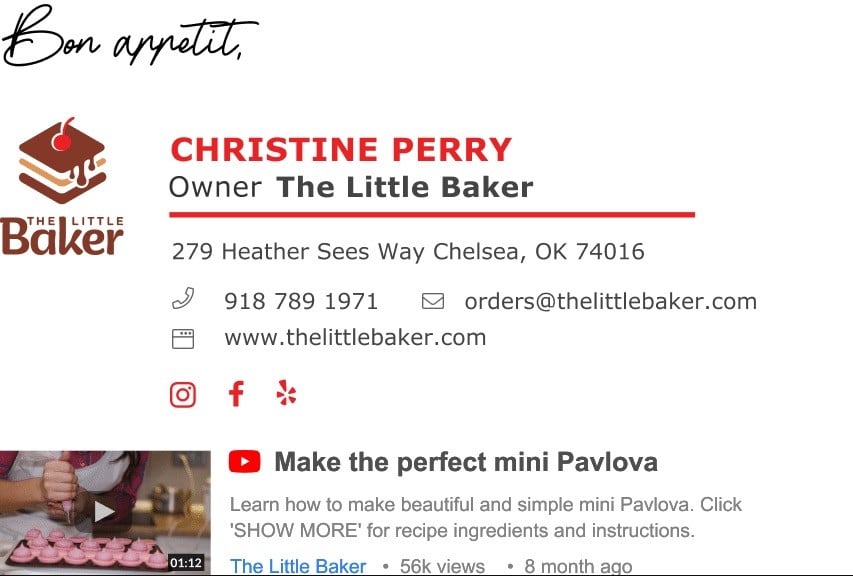
When creating an email sign-off banner, consider its size: 320px wide goes for smartphone screens and 600px are for PC/Mac. JPEGs or GIFs formats work best for images in signatures. However, do your best to keep them below 50KB to prevent slow downloading.
#5. Be unique
With tons of ready-made templates and email signature tools available, there’s a risk of following the same sign-off format as dozens of other marketers. Don’t be afraid of experiments. Think outside the box and try something different to make your emails even more memorable.
Below are just a few ideas, but remember that the sky’s the limit – as long as it matches your brand voice and target audience, of course:
- Add a P.S. after your signature. It’s eye-catching, and it’s another chance to attract readers’ attention to your message.
- Place an email sign-off at the beginning of your email. Who says it should be at the end?
- Write something motivational in your sign-off to inspire subscribers.
- Add a reel of photos or “yummy” GIFs if your brand voice and nature allow.
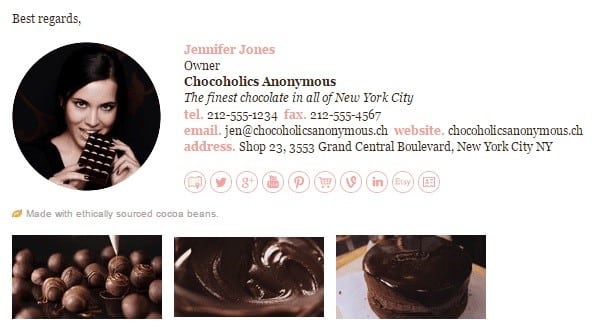
Ready to sign off your emails with these rules and tips at hand?
While some specialists continue to underestimate the marketing role of email sign-off, it has evolved into a powerful marketing tool.
Marketers, sales managers and bloggers design email sign-offs to raise brand awareness, engage consumers and drive conversions.
Now that you know the core principles of how to sign off an email, it’s time to design yours for better customer engagement. Personalize it, keep colors and styles consistent, follow your brand tone of voice and experiment to make your email sign-off stand out.
Add an email signature to your automated campaigns, get data about their click-through rates and optimize the process accordingly. But remember to test your emails first to ensure they make it to people’s inboxes.
Lesley Vos is a professional copywriter and guest contributor, currently blogging at Bid4Papers, a platform that helps students and authors with writing solutions. Specializing in data research, web text writing, and content promotion, she is in love with words, non-fiction literature, and jazz.
Table of Contents
- What is an email sign-off?
- The psychology behind email language: why email sign-offs matter
- Features to include in your email sign-offs
- A photo
- A phone number
- A logo and a slogan
- How to sign off an email: 5 rules for better engagement
- #1. Make your email sign-off personal
- #2. Design it to match your branding
- #3. Optimize for mobile devices
- #4. Try banners to boost conversions
- #5. Be unique
- Ready to sign off your emails with these rules and tips at hand?
